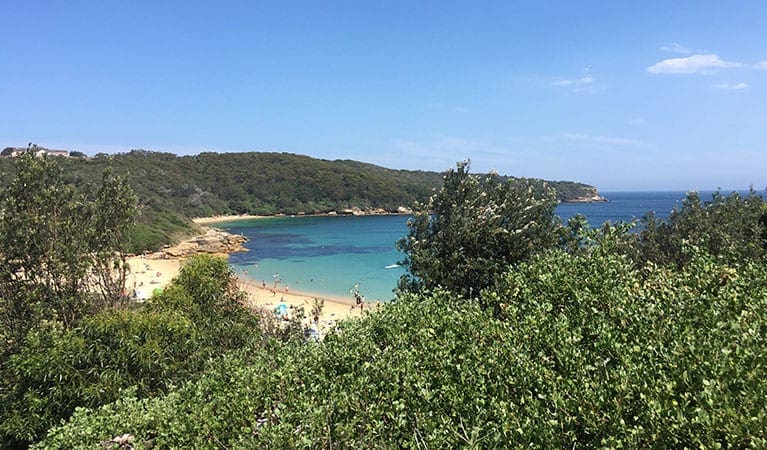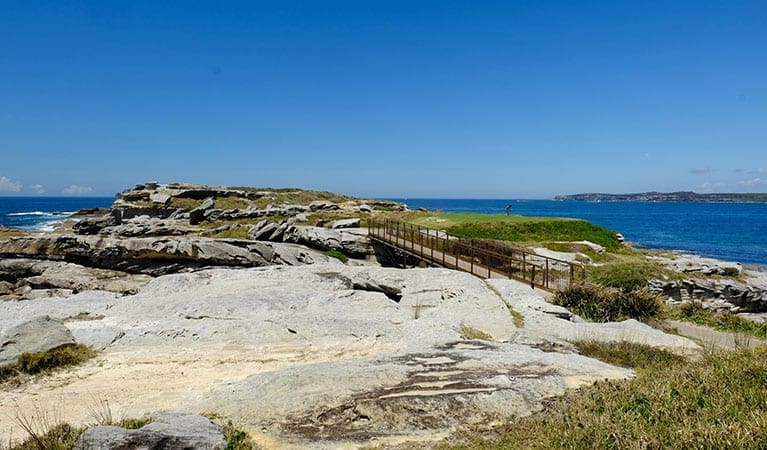Hike at a Glance
Max elevation: 0m
Min elevation: 0m
Total Ascent: 0m
Hike overview
Western Escarpment walking track winds through an island of unspoiled bushland in Sydney's eastern suburbs. Purpose-built by Randwick City Council and NSW National Parks, the track connects South Maroubra Beach with Malabar and is a vital new link in the iconic Eastern Beaches coastal walkway.
Starting from Arthur Byrne Reserve or Pioneers Park you'll climb the exposed sandstone escarpment. There are seats along the way to stop and soak in the natural beauty. At its highest point, the walk treats you to 3600 views over Malabar Headland, Maroubra Beach, and Botany Bay from a natural sandstone platform.
This protected area teems with bird and animal life. Keep an eye out for red wattlebirds, new holland honeyeaters and blue fairy wrens in the heath. You might spot kestrels and sea eagles searching for prey above, as you walk through the endangered eastern suburbs banksia scrub.
Why not combine your nature walk with a day at Maroubra or Malabar Beach, or picnic at the nearby public parks? For a longer walk, connect with Boora Point walking track in the eastern section of the park (when it's open) for a 5km loop, or continue along the Eastern Beaches coastal walkway.
Tips
Please stay on the marked track to protect the sensitive vegetation and avoid hazards.
Bring your binoculars during June and July to spot migrating humpback whales or frolicking seals off the coast.
This walk offers a year-round alternative to Boora Point walking track, which closes when the ANZAC Rifle Range is in use.
Visit NSW National Parks and Wildlife Service for more information on this trail.
The longitude and latitude of the start and end points are approximately only and should not be used for navigation purposes. Please contact me if you know the correct coordinates.
Gallery
Got some great shots from this hike? Upload your photos here to inspire others and show off the beauty of the trail!
Click to view form >>
Submitting your photos doesn’t mean you lose ownership. You can be credited for your contributions, and you can request removal at any time.
Content use
Please don’t copy GPX files or content from this site to AllTrails or other platforms. Each trail has been personally mapped, documented, and refined to support Australia’s bushwalking and hiking community. While some details come from land managers, every listing reflects significant personal effort. This is a free, community-driven initiative—your respect helps keep it that way.
Walk map and GPX file
It looks like I don’t have a GPX file for this trail yet. If you have one to share, please email it to me! I’ll verify it against official maps before adding it to help other hikers have a safer, easier experience. Thanks for contributing to a better hiking resource.
Getting there
Getting to the trailhead: Malabar Headland National Park.
Western Escarpment walking track is in the western section of Malabar Headland National Park. To get to Arthur Byrne Reserve carpark from Sydney city:Drive south along Anzac ParadeTurn left onto Fitzgerald Avenue towards Maroubra BeachAt the roundabout, take the 3rd exit onto Bernie Kelly DriveThe carpark is at the end of Bernie Kelly DriveTo get to Pioneers Park carpark from Sydney city:Drive south along Anzac Parade, passing through MaroubraPioneers Park is on your left, before you reach MalabarFollow the Pioneers walking track around 350m to the north of the carpark to reach the national park and track head Parking Free parking is available at the south end of Maroubra Beach at Arthur Byrne Reserve carpark. The track head is 50m from the carpark. You can also park at Pioneers Park in Malabar. The track head is 350m from the carpark.
Closest towns to this walk: Atherton, Chifley, La Perouse, Little Bay, Malabar, Malanda, Maroubra, Millaa Millaa, Randwick, Tarzali, Yungaburra
About the region
Malabar Headland National Park in the Sydney and surrounds region
Eastern section: Often closed because of the ANZAC rifle range operation. Closed every Saturday and every 1st and 3rd Sunday of the month. Check local alerts and safety messages before visiting. Western section: Open all year but may close at times due to poor weather or fire danger.
Similar walks nearby
Looking for more walks in or near Malabar Headland National Park? Try these trails with a similar difficulty grade.
Track grade
Grade 3 (Moderate) - Walks for Most Fitness Levels: Grade 3 on the AWTGS represents moderate walking tracks. These are ideal for walkers with some fitness who are comfortable with some hills and uneven terrain. While suitable for most ages, some bushwalking experience is recommended to ensure a safe and enjoyable experience. Tracks may have short, steep hill sections, a rough surface, and many steps. The total distance of a Grade 3 walk can be up to 20 kilometers.
Explore safe
Plan ahead and hike safely! Carry enough water, pack layers for changing conditions, and bring safety gear like a torch, PLB, and reliable communication device. Check official sources for trail updates, closures, and access requirements, and review local weather and bushfire advice. Most importantly, share your plans with someone before you go. Being prepared makes for a safer and more enjoyable hike! Stay Safe, Explore More, and Always #ExploreSafe.
Packing checklists
What you carry in your pack depends on factors like weather, terrain, and your adventure type. Not sure what to bring? My free planning, food, and packing checklists are a great starting point, covering day hikes, overnight trips, and multi-day adventures. Use them to customise your kit and always prioritise safety.
Let someone know
Before heading out, take a moment to fill out your trip intentions form. It’s a quick way to share your hike details with family or friends. If something goes wrong, they can notify emergency services, ensuring a faster response and peace of mind. Stay safe and enjoy your adventure
Suggest an edit
Spotted a change on this trail? Maybe there are new features, the route has shifted, or the trail is permanently closed. Whatever the update, I’d love your input. Your feedback helps fellow hikers stay informed and ensures that our trail info stays fresh and reliable.
Acknowledgement of Country
Trail Hiking Australia acknowledges the Traditional Owners of the lands on which we hike and pay respects to their Elders, past and present, and we acknowledge the First Nations people of other communities who may be here today.






